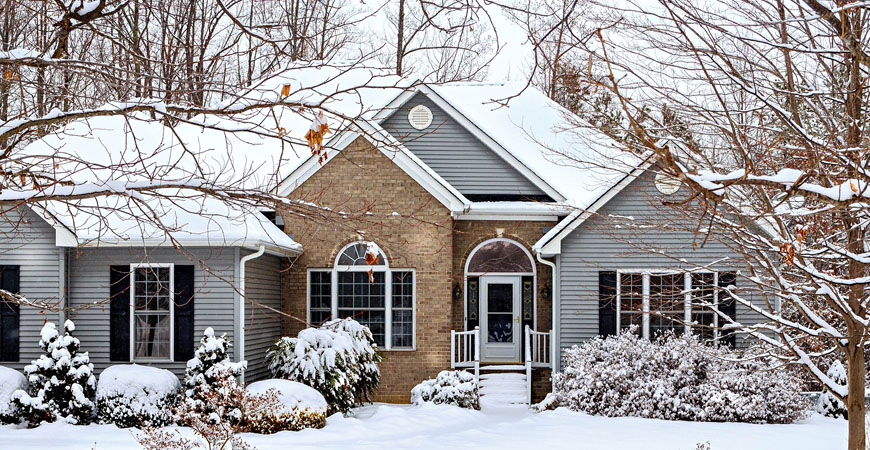
Repairing Winter Storm Damage in Your Lawn and Landscape
Have winter storms wreaked havoc on your lawn? Are you dealing with broken shrubs or fallen tree branches? You may be wondering if your homeowner’s insurance will cover the damage.
Read on for info and how-tos on lawn and yard winter storm damage repair.
Does my lawn have salt damage?
First, inspect your yard after winter – look for broken or fallen branches, and brown patches on the lawn. Other evil-doers include city snowplows, plus sand and salt trucks.
Clearing city streets of snow and ice after winter storms may be necessary, but the remaining salt water can harm your lawn and landscape. Road salt draws moisture from grass and landscape plants, causing dehydration.
Most city lawns are next to residential streets and roadways, meaning salt can buildup on your property after a storm and cause problems. Finding yellow or brown blades of grass may be an indicator of where salt harmed the yard.
In spring, check to see whether your grass is dormant or dead. Rake a section of brown grass and look down between the blades. If you see green, the area should regrow with no winter weather. If not, apply a gypsum soil conditioner to help reverse the damage.
Gypsum soil conditioner contains a combination of sulfur and calcium. These ingredients counteract the salt and help retain moisture in the soil.
To renew a salt-damaged lawn –
- Rake out the dead grass.
- Add a gypsum soil conditioner.
- Add a thin layer of compost + apply new grass seed.
- Water often until seedlings are established.
To fix brown lawn patches –
- Remove the brown area, plus a few inches of the underlying soil.
- Apply a layer of compost or topsoil.
- Lightly rake new grass seed into the top layer.
- Lightly tamp down.
- Water often until seedlings are established.
Extra tips:
- Snowplows and sand trucks are notorious for throwing sand into yards. Use a shop vac to pick up sand and small stones from your lawn, garden beds, and sidewalk.
- Wrap your landscape plants in burlap to protect them from salt and sand truck over-spray.
How to repair lawn damage from heavy snow cover –
Deep piles of snow and ice on your lawn for extended periods can compress the soil and eventually kill the grass. Gypsum will loosen the soil and improve drainage.
Loosen the dirt with a rake and apply gypsum – a 40-pound bag will cover approximately 200 sq. ft.
How to repair damage to trees/shrubs caused by salt truck de-icer –
If you notice branch dieback or yellow leaves in spring, your landscape plants may have been harmed by road salt. If you suspect salt has landed on your landscape plants, spray them with the hose and deep-water the soil to rinse away any residual salts. Spring rains will wash away any remaining residue.
How to repair damage to trees/shrubs caused by heavy snow cover –
A heavy snow or ice storm can weigh down and break branches. Look for broken or splintered branches and prune them. If they’re large or out of reach, call a landscape professional to have them removed.
Trees and shrubs with broken spots are more susceptible to disease and insects. So, it’s important to remedy the problem as quickly as possible.
Extra tips:
- Don’t shake bent, snow-covered tree limbs – they can break. Carefully remove the snow from ground-level branches by brushing it away with your hands.
- Shoveling snow – If you suspect the snow on your driveway or walkway contains salt, avoid piling snow near your landscape plants. As the snow melts, it will transfer salt to the soil.
Help for Hardscaping
Masonry, stone, brick, and concrete are sturdy materials, but they are also susceptible to salt damage. Thoroughly rinse hardscape surfaces with water to remove salt – check them for pitting or rough spots.
Repair damage with a concrete patch. Apply a sealer to protect it from future damage.
Mortar damage – The mortar between bricks, pavers, and stones can become loose when repeatedly exposed to saltwater. If you find areas of weak or crumbling mortar, reset the material, add fresh mortar, and seal the surface to prevent salt from working its way into the mortar.
Contact a licensed contractor for repairs for elaborate stonework or specialty concrete surfaces.
Extra tip: Some salt damage may worsen for several weeks – even after cleaning. Wait a few months before applying a sealer – you may discover that some surfaces will need replacement.
Will homeowner’s insurance cover winter storm damage?
The answer is that it depends. A standard homeowner’s insurance policy can help cover certain types of winter weather and storm damage –
- Damage from water, ice, and hail – coverage for ice and water damage may vary, depending on the cause.
- Wind and fallen trees – If storms come barreling through your neighborhood, you may find that your roof shingles are damaged. Homeowner’s insurance usually covers damage due to high winds.
- Lightning strikes and power surges – If lightning strikes your home or other covered structure, any resulting damage such as fire or smoke is usually covered by homeowner’s insurance. Some policies also cover outages and damage due to power surges that result from a lightning strike. This includes damage to electronics and household appliances.
Most standard policies do not cover damage due to –
- Floods
- Earthquakes
As with most coverage, limits will apply. Read your insurance policy to discover what types of weather and winter storm damage may or may not be covered.
Don’t feel defeated when reviewing your lawn after the prolonged winter weather and storms! The above tips and how-to’s on repairing winter weather and storm damage will help you revitalize your yard in no time.
Be sure to take care of any moss or organic growth on your roof, so it doesn’t void the homeowner’s insurance.














